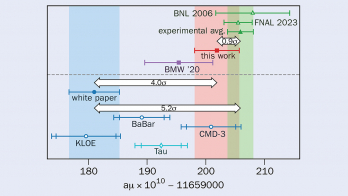by Leonard Susskind, Little Brown and Company. Hardback ISBN 0316155799, $24.95.

In some theoretical physics institutes, uttering the words “cosmic landscape” may give you the feeling of walking into a lion’s den. Leonard Susskind courageously takes upon himself the task of educating the general public on a very controversial subject – the scientific view on the notion of intelligent design. The ancestral questions of “Why are we here?”, “Why is the universe hospitable to life as we know it?” and “What is the meaning of the universe?”, are earnestly addressed from an original point of view.
Darwin taught us that, according to the theory of evolution, our existence in itself has no special meaning; we are the consequence of random mutation and selection, or survival of the fittest. This is a baffling turn of the Copernican screw, which puts us even farther away from the centre of the universe. We live in the age of bacteria and we are nothing but part of the tail in the distribution of possible living organisms here on Earth.
A possible counter to this reasoning is the notion of a benevolent intelligence that designed the laws of nature so that our existence would be possible. According to Susskind, this is a mirage. Using current versions of string theory and cosmology he provides yet another turn of the Copernican screw. A good aphorism for this book can be found on p347 – the basic organizing principle of biology and cosmology is “a landscape of possibilities populated by a megaverse of actualities”. This may sound arcane, but the book gives a consistent picture based on recent scientific results that support this view. This is no paradigm shift, but an intellectual earthquake.
The author masterfully avoids the temptation to give a detailed account of our understanding of particle physics and cosmology. Instead, he provides an impressionistic, but more than adequate, description of the theories that have inspired us over the past 30 years, some verified experimentally (such as the Standard Model) and some more speculative (such as string theory). A more accurate description may have kept many readers away from the book, yet enough information is given to grasp the gist of the argument.
The main theme is the understanding of the cosmological constant – Albert Einstein’s brainchild, which later he called the biggest blunder of his life – the numerical value of which has been measured by recent astronomical observations. The numerical value of the universal repulsion force represented by this constant simply boggles the imagination. In natural units (Planckian units, as explained in the book) it is a zero, followed by 119 zeroes after the decimal point and then a one. Fine-tuning at this level cannot be explained by any symmetry or any other known argument. It is 120 orders of magnitude, something to make strong men quail.
We can appeal to the anthropic principle, but this is often taken as synonymous with the theory of intelligent design. Susskind avoids this temptation by turning to our best bet yet to unify, or rather make compatible, quantum mechanics and general relativity – string theory. Work from Bousso Polchinski and others implies that string theory contains a bewildering variety of possible ground states for the universe. In recent counts, the number is a one followed by 500 zeroes – a nearly unimaginably big number – and most of these universes are not hospitable to bacteria or us. However, the number is so big that it could perfectly accommodate some pockets where life as we know it is possible. No need then to fine-tune; the range of possibilities is so large that all we need is a procedure efficient enough to turn possibilities into actualities.
This is the megaverse provided by eternal inflation. The laws of physics allow for a universe far bigger than we have imagined so far and as it evolves it creates different branches, which among other properties contain different laws of physics, sometimes those that allow our existence.
This is radical, hard to swallow, and against all the myths that the properties of our observed and observable universe can be calculated by an ultimate theory from very few inputs – but it is remarkably consistent.
The topics analysed in this book are deep – it deals with many of the questions that humans have posed for millennia. It is refreshing to find a hard-nosed scientist coming out to address such controversial questions in the public glare, without fearing the religious or philosophical groups (or even worse, his colleagues), who for quite some time have monopolized the discussion.
Despite the difficult questions raised, when unfamiliar concepts are introduced, one finds a humorous punctuation based on the author’s personal experience, which lets you recover your breath. Some will find the arguments convincing, some will find them irritating, but few will remain indifferent.








